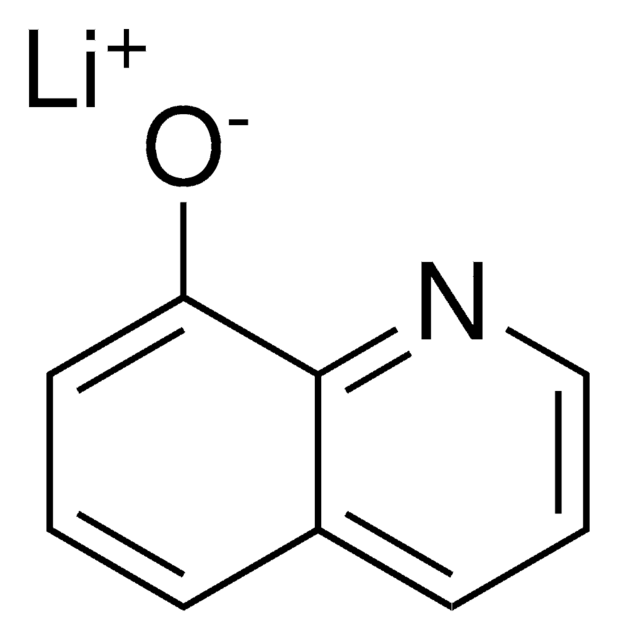697737
Tris-(8-hydroxyquinoline)aluminum
sublimed grade, 99.995% trace metals basis
Synonym(s):
8-Hydroxyquinoline aluminum salt, Alq3, Aluminum 8-hydroxyquinolinate, Aluminum oxinate, Tris-(8-hydroxyquinolinato)aluminum
About This Item
Recommended Products
grade
sublimed grade
Assay
99.995% trace metals basis
form
solid
loss
0.5 wt. % loss on heating, 332°C (typical, TGA)
mp
>300 °C (lit.)
411 °C (DSC)
λmax
259 nm
fluorescence
λex 390 nm; λem 519 nm
Orbital energy
HOMO 5.8 eV
LUMO 3.1 eV
OLED Device Performance
ITO/MoO3/NPD/Alq3/BPhen/LiF/Al
ITO/NPD/CBP:Ir(ppy)3/BCP/Alq3/Mg:Al
ITO/NPD/TCTA/BCPO:Ir(piq)3 (7-8%)/BCP/Alq3/LiF/Al
ITO/NPD/TCTA/BCPO:Ir(ppy)3 (7-8%)/BCP/Alq3/LiF/Al
ITO/m-MTDATA/NPD/TTPhPhB/Alq3/LiF/Al
SMILES string
O([Al](Oc1cccc2cccnc12)Oc3cccc4cccnc34)c5cccc6cccnc56
InChI
1S/3C9H7NO.Al/c3*11-8-5-1-3-7-4-2-6-10-9(7)8;/h3*1-6,11H;/q;;;+3/p-3
InChI key
TVIVIEFSHFOWTE-UHFFFAOYSA-K
Looking for similar products? Visit Product Comparison Guide
Related Categories
General description
Application
Signal Word
Warning
Hazard Statements
Precautionary Statements
Hazard Classifications
Eye Irrit. 2 - Skin Irrit. 2 - STOT SE 3
Target Organs
Respiratory system
Storage Class Code
11 - Combustible Solids
WGK
WGK 3
Flash Point(F)
Not applicable
Flash Point(C)
Not applicable
Personal Protective Equipment
Certificates of Analysis (COA)
Search for Certificates of Analysis (COA) by entering the products Lot/Batch Number. Lot and Batch Numbers can be found on a product’s label following the words ‘Lot’ or ‘Batch’.
Already Own This Product?
Find documentation for the products that you have recently purchased in the Document Library.
Customers Also Viewed
Articles
Silylethyne substitution offers an opportunity to tune solubility for application-specific needs and self-assembly for electronic performance and has yielded semiconductors with excellent device performance.
Silylethyne substitution offers an opportunity to tune solubility for application-specific needs and self-assembly for electronic performance and has yielded semiconductors with excellent device performance.
Silylethyne substitution offers an opportunity to tune solubility for application-specific needs and self-assembly for electronic performance and has yielded semiconductors with excellent device performance.
Silylethyne substitution offers an opportunity to tune solubility for application-specific needs and self-assembly for electronic performance and has yielded semiconductors with excellent device performance.
Our team of scientists has experience in all areas of research including Life Science, Material Science, Chemical Synthesis, Chromatography, Analytical and many others.
Contact Technical Service









